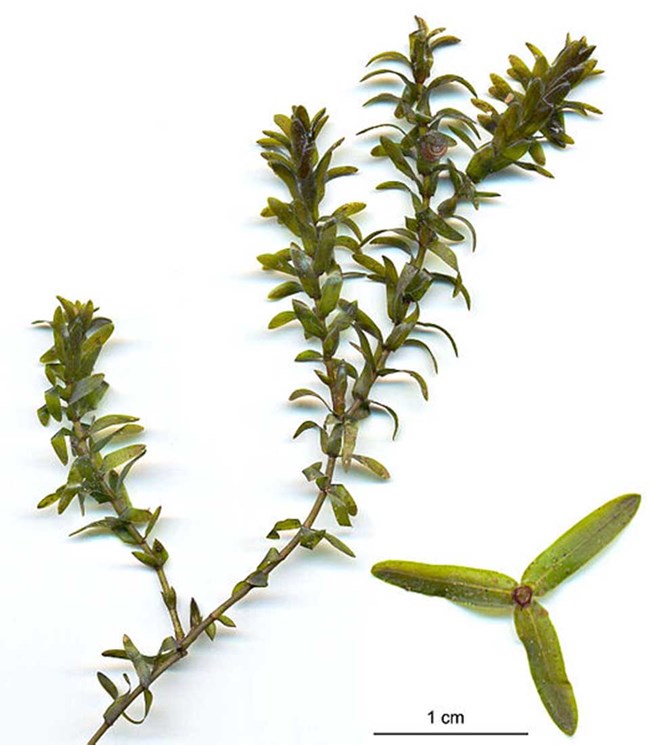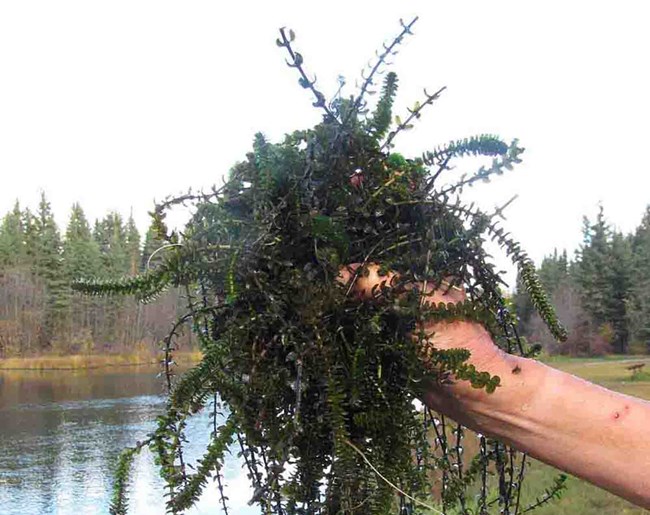Exotic invasive plant species can outcompete native species for limited resources and alter ecosystem structure and function. Throughout Alaska, over 280 non-native plant species have been documented, accounting for approximately 13.5% of the flora. Alaska parks have remained relatively undisturbed and to a large extent retain the native flora; however, the likelihood that exotic plants will become established is increasing, due to a warming climate and increasing development and tourism.
The National Park Service’s Alaska Exotic Plant Management Team regularly conduct exotic plant surveys in Alaska parklands. Recently some parks have also conducted presence/absence surveys for the aquatic invasive plant, Elodea.
Elodea is the first submerged aquatic invasive plant to become established in Alaska. It was originally found in Eyak Lake, near Cordova, in 1982. Since then, it has been documented in 19 other water bodies in the state. In 2015, it was found in Anchorage in Lake Hood, the world’s busiest floatplane base. At present, no confirmed infestations exist within park boundaries; however, this could change given the importance of floatplanes in accessing parks and the significance of floatplanes as a vector in spreading Elodea.

Photo courtesy of the Kenai Cooperative Weed Management Area.
Elodea
is a highly invasive submerged aquatic plant that can cause environmental and economic impacts in Alaska’s waterbodies. It can take root in lakes and slow-moving rivers and streams. It even grows under the ice during the winter.Elodea canadensis and E. nuttallii (and hybrid, Elodea canadensis x nuttallii) are highly invasive aquatic plants that can choke out native vegetation and impair habitat for waterfowl and freshwater fish species. Elodea is most likely to be found in lakes and slow-moving, neutral-to-alkaline rivers with thick sediments and near population centers, though it can colonize at lower densities in fast-flowing rivers with gravel substrates, and has even been found in brackish waters. It is tolerant of cold water temperatures and survives freezing, which gives it a competitive advantage over native species.
Elodea is a common aquarium plant and was likely introduced to Alaska by people dumping their aquaria contents into rivers, lakes, and ponds. Once introduced, it can spread by small fragments transported from lake to lake on waders, boats and boat trailers, floatplanes, and other equipment.
The first documented occurrences of Elodea were in Eyak Lake (near Cordova) in 1982, and Chena Slough (near Fairbanks) in 2009. Since 2010, it has been documented in additional locations near Cordova; lakes in Anchorage; and lakes on the Kenai Peninsula (where it has been treated).
The Alaska Department of Natural Resources and federal land management agencies are working together and with citizen cooperative weed management areas in the prevention, management, and eradication of the Elodea. The State of Alaska has recently banned the sale of Elodea spp.
What it looks like
- Leaves in whorls of 3 or occasionally 4, unlike native species
- Leaves are ¼” to ½” long and finely toothed
- Stems are lighter green than the leaves and grow in a tangled mass
- Submerged leaves are densely packed along the stem
Impacts
- Fouls boat propellers and float plane rudders, creating a safety hazard.
- Degrades fish habitat, including salmon spawning, and displaces native plants and animals.
- Alters freshwater habitats by decreasing flow and increasing sedimentation.
- Reduces property values by fouling launch sites and nearshore habitats.
How it spreads
- Even tiny fragments can root and generate new plants.
- Fragments of the plant can be carried between water bodies on boats, trailers, float planes, and gear.
- Since the plant can grow under the ice, plant fragments can be caught in ice during break up and be carried downstream.
What you can do
- Clean and rinse boats, trailers, floatplanes, and other gear.
- Drain coolers, bilge pumps, buckets, and wring out gear before leaving a waterbody.
- Completely dry equipment and gear between visits to freshwater systems
- Never release plants, fish, or other animals into a body of water.
If you find Elodea
- Note its location with GPS coordinates or marked on a map.
- Take a picture and take a specimen. Take as much of the entire plant as you can, including the flowers, if it has some. Enclose the specimen in a sealed bag and keep it cool. If you don’t have a bag, press it in a book and keep it secure.
- Report it. Call the Alaska Department of Fish and Game’s invasive species hotline: 1-877-INVASIV (468-2748)

NPS
Last updated: February 16, 2018
